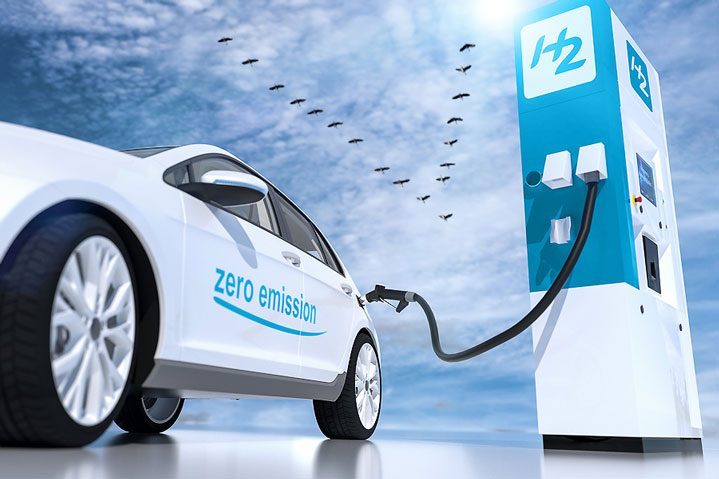Hydrogen From A to Z: V For Vehicles
By: GenH2 Staff
Read Time: 4 minutes
Defining the Hydrogen Economy from A to Z: V is for Hydrogen Vehicles
Continuing on in our defining the Hydrogen economy from A to Z series, we are focusing on the letter V and discussing Vehicles, particularly those powered by Hydrogen.
The definition of a vehicle is a thing or machine used for transporting people or goods and that covers a diverse list of types. Forklifts, cars, trucks, trains, and airplanes are the types of vehicles that are a big and important part of our national and global economies. The plans for increased use of Hydrogen-powered vehicles will play a key role in reducing global emissions in travel and transport. Here are some examples of the diversity of vehicles that are using or considering using hydrogen as the energy carrier across different methods of transportation:
Hydrogen Cars and Trucks
In the advancements of electric vehicles, the use of hydrogen currently as the power for the fuel cells is becoming an excellent alternative to battery electric vehicles (BEVs), when it comes to zero emissions mobility. Some car manufacturers have choices in hydrogen-fueled cars that can currently be leased or purchased. Companies such as Van Hool, Hyundai, Siemens, and Toyota are included.
In hydrogen truck vehicles, Hydrogen garbage trucks are the next solution in helping reduce emissions in urban cities across America. Hydrogen-powered refuse collection trucks are already on the streets in places like Sweden and Scotland and are being evaluated throughout Europe. Heavy-duty trucks are also another group making strides in the use of hydrogen-powered vehicles. Hyson, Nikola, and Toyota are some of the companies working on hydrogen-powered trucks.
Hydrogen Trains
Trains as a hydrogen-powered vehicle/s are also heading for a breakthrough in decarbonization. Electric trains currently use diesel engines to generate electricity to power them and now there are initiatives and steps being taken to use hydrogen as the replacement energy carrier for rail and trains. America’s first hydrogen Artikel – Stadler fuel cell train, FLIRT H2 is expected to be operational in San Bernadino, California in 2024. Globally, rail and trains are a particularly suitable means of transitioning to hydrogen usage without requiring too much additional electric infrastructure. Public service in places like Germany and China, hydrogen trains already create their own electricity onboard.
Hydrogen Planes
An example of hydrogen planes becoming a reality, Airbus announced plans to make aviation travel emissions-free with ZEROe. In 2022 the hybrid-hydrogen ZEROe demonstrator leads the way in developing the world’s first zero-emission commercial aircraft by 2035. According to Airbus, the ZEROe hydrogen-powered concept can pave the way for greener air travel, reducing the aviation industry’s carbon footprint by upwards of 50%.
Marine Vehicles – Shipping and Cruising
Marine vehicles and shipping industries are also addressing hydrogen as an alternative fuel choice for working towards zero emissions in maritime shipping worldwide. A key advantage of hydrogen over other fuel alternatives is the relative ease of retrofitting existing ships with hydrogen fuel cells. Hydrogen-powered ferries and smaller shipping vessels have been piloted in the United States, Belgium, France, and Norway. Hyundai Motors is also addressing the small and mid-sized ships/vehicles diesel market by developing a marine mobility platform powered by seawater by 2023.
Royal Caribbean Group’s ultra-luxury brand Silversea Cruises has announced plans to launch a hybrid-powered ship (the cruise industry’s first such vessel), which will include a hydrogen fuel cell in the summer of 2023. The hybrid solution enables the ship to be emissions-free while docked at ports. Carnival Corporation-owned German cruise line also announced its partnership with leaders from the maritime and engineering sectors to pilot the world’s first fuel cell system designed to power large passenger vessels.
Hydrogen vehicles and Infrastructure
The Department of Energy’s (DOE’s) Energy Earthshots Initiative, the International Energy Agency, the European Commission, governments, and cities have long believed that hydrogen is essential to achieving zero emissions in different public transportation vehicles as discussed above. However, to implement the use of hydrogen globally, the infrastructure solutions need to be in place to meet the worldwide hydrogen community goals.
The hydrogen age is now, and the use of hydrogen-powered vehicles is well underway. Companies like GenH2 are focusing on liquid hydrogen infrastructure solutions for meeting hydrogen supply chain needs. Liquid hydrogen leads out for the ultimate solution that can meet the needs in diverse vehicles usage across the spectrum.
Please follow us next week as we explore another letter in our Defining the Hydrogen Economy from A to Z series.



